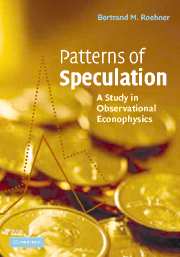6 - SPECULATIVE PEAKS: STATISTICAL REGULARITIES
Published online by Cambridge University Press: 02 December 2009
Summary
“What goes up must go down.” That was the title of an article published in Newsweek on December 16, 1996 which referred to stock market prospects. This warning was of little use to investors however, for one never knows when the downturn really will occur; in this case the bull market went on for about three years. In the present chapter, through a systematic statistical analysis of speculative peaks, we put forward a weaker, but nevertheless useful, formof the previous adage, namely: “The way it goes up, the way it goes down.” In other words, once the market downturn has occurred one can with a reasonable level of confidence predict to what level it will fall back. More generally in this chapter we present a number of statistical regularities observed during speculative bubbles. First, we analyze an indicator that can be used to assess the temperature of speculative frenzy; secondly, we show that speculative price peaks follow a definite pattern that we call the sharp peak–flat trough pattern; thirdly, we study the short-term phenomena connected with stock market crashes; and, finally, we review some of the economic consequences of market collapses.
A “thermometer” of speculative frenzy
In an article that appeared in 1996 in the Financial Times (May 19) Barry Riley wrote: “The [American] stock market's capitalization has risen to almost 90 percent of GDP, beating the previous peak of 82 percent in 1929. The long-run average has been 48 percent.” This observation implicitly suggests that the ratio of stock capitalization to Gross Domestic Product can be a reliable indicator of “speculative temperature.”
- Type
- Chapter
- Information
- Patterns of SpeculationA Study in Observational Econophysics, pp. 122 - 154Publisher: Cambridge University PressPrint publication year: 2002



